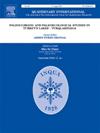Dynamics of sediment formation in barová cave (Moravian Karst) during the last glacial cycle
IF 1.8
3区 地球科学
Q3 GEOGRAPHY, PHYSICAL
引用次数: 0
Abstract
The last climatic cycle in the terrestrial environment is usually recorded in open loess sites. However, the frontal parts of caves often inhabited during the Palaeolithic occupation frequently provide valuable sedimentary archives. We propose that the most effective approach to studying these deposits is dual dating methods combined with micromorphology. Radiometric dating (14C and U-Th) coupled with analysis of sediment formation processes of the sedimentary record indicates that the intensive clearing of Barová Cave occurred at least by the end of the last interglacial, in MIS 4 and early MIS 3. During the period ca. 55-36 kyr BP, i.e., during the main phase of MIS 3, relatively slow sedimentation occurred in the open space in the cave, which created above underlying sediments by the previous clearance. The sedimentary record consists almost exclusively of osteological material showing signs of corrosion, including collagen depletion. This layer of osteological material is overlain by relatively thick clayey sediments, again with a number of animal bones dated consistently to MIS 3, representing a rapid erosional phase. This erosional phase is likely associated with the transition between MIS 3 – MIS 2. MIS 2 itself includes one of the coldest and driest periods of the Last climatic cycle, i. e. Last Glacial Maximum (LGM), which is represented in the cave record by redeposited loess showing signs of freezing. The onset of the Holocene is marked by a continuous layer of sinter. The combination of 14C, U-Th, and sedimentological and micromorphological analyses has proven to be an effective approach for interpreting the site's formation history and its relationship to climatic changes during the last climatic cycle.
末次冰期旋回巴罗夫洞(摩拉维亚喀斯特)沉积物形成动力学
陆地环境的最后一次气候循环通常记录在开阔的黄土遗址。然而,在旧石器时代经常有人居住的洞穴的前部经常提供有价值的沉积档案。我们认为研究这些矿床最有效的方法是结合微观形貌的双重测年方法。放射性测年(14C和U-Th)结合沉积记录的沉积形成过程分析表明,barov洞的强烈清理至少发生在末次间冰期末,即MIS 4和MIS 3早期。在大约55- 36kyr BP期间,即在MIS 3的主要阶段,在洞穴的开放空间中发生了相对缓慢的沉积,这是由于先前的清理而形成的在下伏沉积物之上。沉积记录几乎完全由显示腐蚀迹象的骨材料组成,包括胶原蛋白耗竭。这层骨材料被相对较厚的粘土沉积物覆盖,上面还有许多动物骨骼,它们的年代一致为MIS 3,代表了一个快速的侵蚀阶段。这个侵蚀阶段可能与MIS 3 - MIS 2之间的过渡有关。MIS 2本身包括最后一个气候周期,即末次盛冰期(LGM)中最冷和最干燥的时期之一,在洞穴记录中表现为重新沉积的黄土显示冻结的迹象。全新世的开始以连续的烧结层为标志。14C、U-Th、沉积学和微形态分析相结合已被证明是解释遗址形成历史及其与上一个气候周期气候变化关系的有效方法。
本文章由计算机程序翻译,如有差异,请以英文原文为准。
求助全文
约1分钟内获得全文
求助全文
来源期刊

Quaternary International
地学-地球科学综合
CiteScore
5.60
自引率
4.50%
发文量
336
审稿时长
3 months
期刊介绍:
Quaternary International is the official journal of the International Union for Quaternary Research. The objectives are to publish a high quality scientific journal under the auspices of the premier Quaternary association that reflects the interdisciplinary nature of INQUA and records recent advances in Quaternary science that appeal to a wide audience.
This series will encompass all the full spectrum of the physical and natural sciences that are commonly employed in solving Quaternary problems. The policy is to publish peer refereed collected research papers from symposia, workshops and meetings sponsored by INQUA. In addition, other organizations may request publication of their collected works pertaining to the Quaternary.
 求助内容:
求助内容: 应助结果提醒方式:
应助结果提醒方式:


